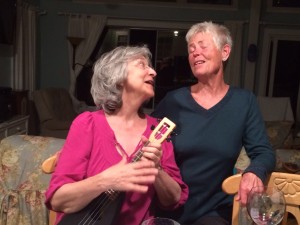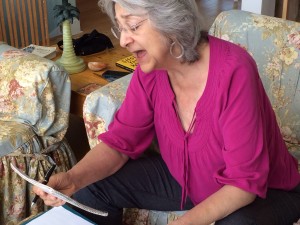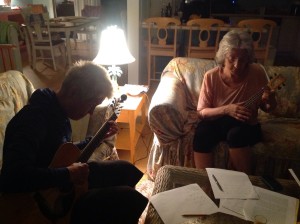St. Vincent Island: An Anthem

Velma Frye and Becky Reardon
Last May, New Mexico composer and singer Becky Reardon and Florida’s beloved songwriter and performer Velma Frye joined me for a week to explore St. Vincent Island, on the northwest Florida coast. The island, a National Wildlife Refuge, became both inspiration and subject of an anthem written by the two musicians. I was the privileged observer of their creative process—the only observer, besides the dolphins and the wild birds. My contribution was to introduce the artists to the island and its wildlife, touring them on foot and by kayak, and once with Jeff and his boat.
“St. Vincent Island” is ready for its public debut now, nine months after conception. The recent illegal takeover of Oregon’s Malheur National Wildlife Refuge, as well as unspeakable forays against Florida’s state parks and public lands, remind me that we need every kind of advocacy and passionate outcry on behalf of our wild places.
If you’d like to hear our Refuge’s new anthem, click here:
Here are the score and words to the song: Saint Vincent Island in key of C
Please read on and immerse yourself in the creative processes of artists Velma Frye and Becky Reardon. The format is question and answer, taken from a series of conversations and interviews we’ve shared this past year.
Sue: Tell me why you both devoted so much time composing and recording this song.
Becky: As I read your book, Coming to Pass: Florida’s Coastal Islands in a Gulf of Change, I began to dream of a song-writing adventure, a creative collaboration among you and Velma and me at Indian Pass. I knew we had just the right combination of skills.

St. Vincent Island, by David Moynahan
Velma: We felt like St. Vincent Island needed an anthem. Whenever someone sings it, they will be reminded about how beautiful this Refuge is, and why we should protect it.
Becky: That’s right. I often think about the question of a songwriter’s responsibility at this time on the planet. It’s very important to speak up, to be a voice. I wondered how we could write a song of both celebration and concern. Velma and I asked ourselves: What is a prototype of the song that celebrates the commons? We thought of Woody Guthrie’s “This Land is Your Land,” and initially wrote lyrics to fit his melody, although in the end we composed our own tune.
Sue: What were the particular challenges in writing a song of advocacy?

Becky the intrepid
Becky: We had to take everything we’d seen and read, this huge block of information, and turn it into something relatively short and singable. The red knots, the eagles, the mingling of waters between the Pass and the Gulf of Mexico. All the different little micro-ecologies!
Velma: “This Land is Your Land” was a good prompt, because we thought it was important to keep our song simple.
Becky: Yes, we wanted something that people could sing right away. I tend to compose music with a lot of complicated chords, but for this song we didn’t let ourselves veer into jazz or classical.
Velma: I wanted something you could learn after hearing it just one time. I followed Becky’s lead on the words. I knew the sentences were forming when Becky sat back in a big chair and closed her eyes. Whenever I see that happen, I stay silent and I wait. You dare not interrupt that creative process.

A working altar for a singer looks about the same as for a writer….
Becky: Then we went away to our separate rooms. We both developed ideas for how the melody should sound. Then we would come back together and play our ideas to each other, back-and-forth. “I like that, how about this….?” Sue: Technically, how do you go about making a song simple and easy to sing?
Velma: By writing melodic patterns within a narrow range, about an octave, and by using repeating rhythmic patterns, quick to learn. The trick was to find descriptive words that added up to about the same number of syllables for the next phrase. Or sometimes we changed the melody to fit the words.
And we wanted the song to sound good a cappella, so we made the melody’s rhythm interesting to hear, even without a guitar or band. Sometimes the sounds of the water and the birds will be the best accompaniment
Sue: Tell me about Heyo, hey-ai-yah. What does that mean?
Velma: There was so much to say about the island that the song was getting too long and too text-heavy, so I suggested adding a super-easy, short phrase that could be sung loudly after each chorus.
Becky: Heyo, hey-ai-yah is a vocable, words that comes from no particular language, at least no human language. I use vocables to express the language of the world–whatever the birds are singing in, or the whales. Think about the howls of the wolves, or sounds made by human babies before they settle on what we think of as language. Those are vocables.

V tries out a tune
Velma: The last few days of our retreat were all about editing. Remember how I worked at that big dining room table, cutting up the various verses that Becky had written and moving them around? Some I just knocked on the floor. We already had the melody. Now we had to make sure the pitches and rhythms and words worked together, with great precision.
Sue: Please explain to me about why the chorus couldn’t be “St. Vincent Island, rare and free, where wild things live in harmony.” I really wanted that word rare in there, Velma!
Velma: I knew that, and that was precious of you to want that word in the song. But to my ear, it didn’t sound good.
Sue: But why not? Rare is precisely how I think about the island.
Velma: As composers, you have to think about the sound, not just the meaning of words. When you sing the second “r” in rare, it closes your mouth. The word we ended up with—green–“St. Vincent Island, green and free,” opens your mouth. “Rare” sounds like a cat wailing, and “rare and” sounds like “rear end!”

Supper on the beach made for happy songwriters!
Sue: I witnessed how the two of you worked together to create “St. Vincent Island” last May. Yet you tell me you’ve never written a song together before. How do you each usually compose your music?
Velma: I write only at certain times of the year, mostly the summer. I save poems and quotes that are meaningful to me, and then when a stretch of space opens up, I read what I’ve collected, over and over and over. Eventually I will hear a song. I work inside with altar and candle, alone, and make the time sacred for songwriting. Often the whole song comes at once. I can hear me singing and playing it, in my head. I hear the melody, the number of beats per bar, the chord qualities and progressions, even the volume, how loud it should be played or sung.
Becky: I spend a lot of time hiking on mountain trails, and down along creeks in New Mexico where I live, and I carry a little notebook with me when I hike. Sometimes I can tune into a song that’s out in the universe somewhere, and I just write it down. When I catch a first line, it’s like a magical thread. The whole song is right there in that first line. It’s like an entrance into a dream. You have to stay in that dream and follow that first image, because the whole song comes from that. You have to follow it, stalk it. You spend the whole rest of the composition doing that, staying true to it. In my dream, my song, I get images that have a lot of sensuous detail. And the music comes with motion, and that motion becomes a sweep of the melody.
Sue: So there you have it: A week I’ll never forget, and a gift of a song we hope is sung widely, especially in Gulf and Franklin counties.
I will leave you with a fragment of a verse that didn’t make the final cut, but summarizes the whole of my personal commitment to the island.

Becky fell in love with the Pass
“From my small kayak, watching the plover
I vowed that I’d never let the fight be over
Keeping St. Vincent Island, rare and free, where wild things live in harmony
St. Vincent Island, let it be, forever a sanctuary!”
On behalf of St. Vincent Island, heartful gratitude to Becky Reardon and Velma Frye!
For more information about Velma and Becky’s music, performances and classes, check their websites:
http://www.beckyreardonmusic.com

Hard at work

Sue this is gorgeous. Can’t wait to visit the island in a few weeks. I am thinking you will be around for the meeting on the 21st we are hoping to visit the reserve on the 20th
Mariana
So lovely!!
Oh, we will, Mariana, would you like us to tour you??
Oh I loved hearing Velma (and Becky too this time) sing their song again. A lovely song about a precious place, inspired by your beautiful and compelling book. Thanks to all three of you for your creative, inspiring advocacy!
I love the process by which Sue’s creativity and vision in her writing inspires another kind of creativity – song writing.
Thank you, Velma, Becky and Sue, for using your vast talents to protect this place that is so wry close to our hearts. We celebrate I song with you!
Thank you, Velma, Becky and Sue, for using your vast talents to protect this place that is so very close to our hearts. We celebrate in song with you!
Thank you so much for your continuing fight to keep St. Vincent Island a jewel in our world. The new anthem is beautiful!
Cheryl, thank you so much. We will never stop finding new ways to give voice to the island!!
Robin, from one advocate to another….thank you for always speaking out.
Kent, it’s really awesome when it happens, and when you notice, as you always do!
And you will be singing it soon with me, dearie!
Freddie, thank you so much!
Shared with Thom on Facebook I just know he loves this! And Barbara, too! Beautiful tribute!
This is masterful, Sue. You are an amazing writer and faithful advocate for beauty. Thank you.
Becky and Velma,
What a gift you have given! Your melody and words keep running through my brain. Can’t wait to visit the island and sing the song with you both.
Becky’s song, “Speak For the River” was instrumental in defeating a dam and reservoir project in central Indiana last year. May this new song bring protection to St Vincent Island.
Connie
Oh, Candace, you are so kind. Thank you, always.
Thank you, Connie, I hope so too!
Thanks for the work you are doing to protect this treasure.